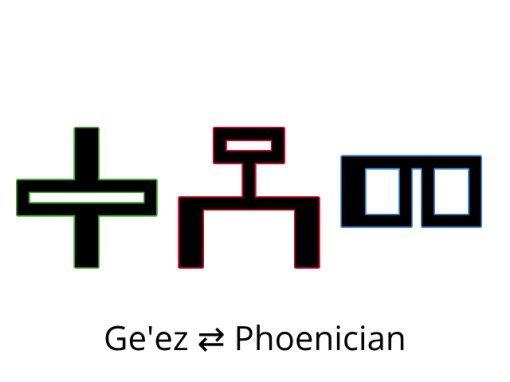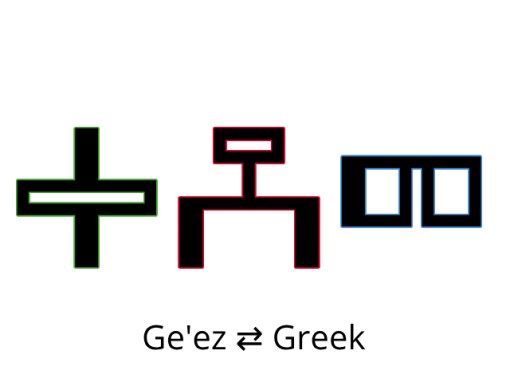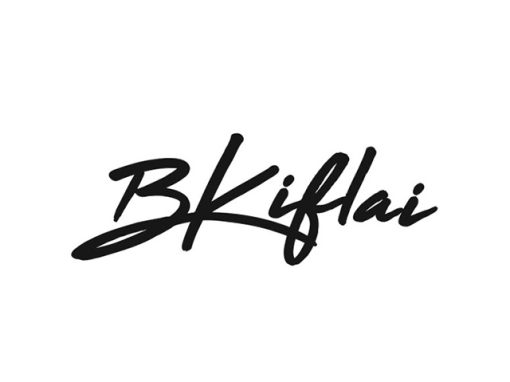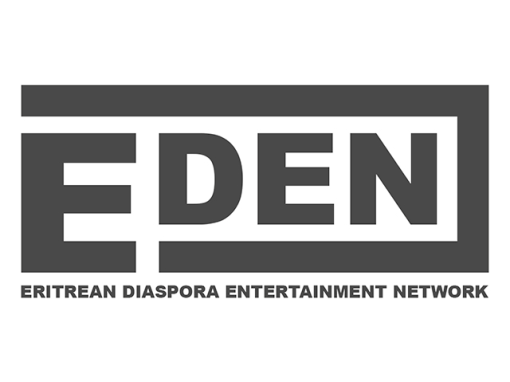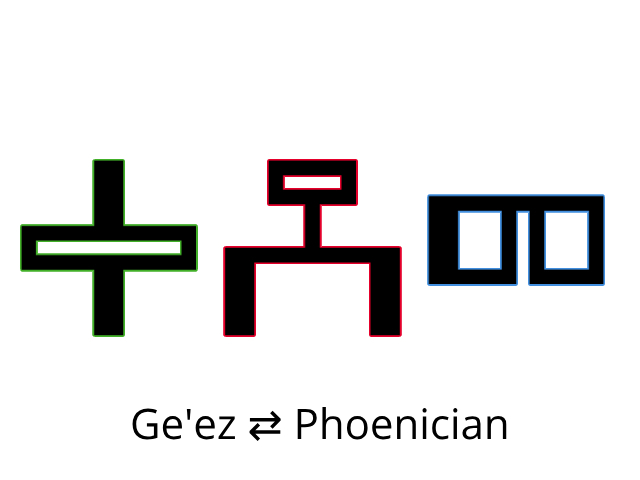
The triliteral root verb qdm is “first” in Ge’ez
or East, precede, beginning, ancient, ancestors… depending on the context
From a-bu-gi-da to alpha-bet
It is said that:
- The Greeks based their alphabet on the Phoenician script and that;
- The Ge’ez script evolved from the South Arabian script which itself is a descendant of the same Phoenician script that the Greeks had adopted for theirs.
“Phoenician” is a Greek exonym.
The people in the region did not call themsleves that. Rather, they broadly referred to themselves as “Kenaʿani.”
As far as Ge’ez is concerned – having the same etymological root as the name መኰንን (mäkwänən) – who we now call the Phoenicians were (collectively) the:
ኰናኒ (kwännani) ruler/governor.
Each Phoenician letter, whether visually or acrophony-wise, bares an uncanny resemblance to it’s Ge’ez counterpart as illustrated below:








The above illustrations have a variation from widely accepted transliterations and thus explanations are included in the below footnotes:
- Ge’ez letters do not have names – or at least they were not assigned acrophonies. This is an indication that, for one reason or another, the African Ge’ez speakers were in no need of these direct intimations for the sounds of the letters for which their oral tradition has categorically insisted has been used by them for millennia. Instead, the Ge’ez acrophonies that I’ve added to the above charts are possible equivalents to the those that the Phoenician teachers had apparently found it necessary to use for teaching their alphabet, introduced by Cadmus.
- 𐤀 (ʾālep) ox – The word for “cow” in Ge’ez is “አሓ (äḥa).” Given the previously-noted Greek B/F/V/W cluster and absent a /p/ phoneme in Ge’ez (ፐ and ጰ were later additions), the alternative acrophony could be “አልቦ (ʾälbo) there is nothing” or conversely “እልፍ (ʾəlf) myriad.”
- 𐤁 (bēt) house – This phoneme/acrophony/translation combination complements “ቤት (bet) house.”
- 𐤂 (gīml) camel – This phoneme/acrophony/translation combination complements “ገመል (gämäl) camel.”
- 𐤃 (dālet) door – This phoneme/acrophony combination complements “ድሌወት (dəlwät).” The Ge’ez definition, however, would either be “weight ” or “worthiness/suitability” because the translation for door is “ኆኀት (h̬oh̬ät).”
- 𐤄 (he) jubilation – This phoneme/acrophony combination complements “ሀለለ (hälälä) jubilate.” As it may be related, it’s important to note that the Ancient Egyptian hieroglyph for “hillul,” 𓀠, is a determinative for words relating to joy or happiness. This glyph, depicting a man with his hands raised on either side, however, may have been used as a base for another voiceless fricative – ሐ (ḥ) – as it has a more truer visual representation along with a comparable definition – “ሐለየ (ḥäläyä) sing / celebrate with songs.”
- 𐤅 (wāw) hook – the closest word with “w-w” letter combination in Ge’ez is “ወውዐ (wäwəʿä) clamor” which seems to be unrelated to it’s Phoenician counterpart. This character – corresponding to ወ – ultimately resulted in five different Latin letters – each with a different phoneme – F, U, V, W and Y.
- 𐤆 (zayin) weapon – This phoneme/acrophony combination complements “ዘየነ (zäyänä) decorate/enrich.” The definition might as well be “unknown” as “weapon” can either directly mean or indirectly infer any number of things.
- 𐤇 (ḥēt) fence – This phoneme/acrophony/translation combination complements “ሐጸረ (ḥäṣärä) fence off.”
- 𐤈 (ṭēt) unknown – The acrophony for the Phoenician letter is not known and the closest sounding Ge’ez counterpart is “ጥዕየት (ṭʿəyät) health.” However, as is the case with the comparison to the Greek θ (theta), ፀ better resembles 𐤈 with a comparable phonetic value.
- 𐤉 (yod) hand – Though it would appear that there would be a relationship with “የማንኢድ (yämanʾid) right hand/hand,” a more similar sounding acrophony would be “የድዐ (yädʿä) inform [sometimes translated as ‘pray’].”
- 𐤊 (kāp) palm – The Ge’ez word for “palm” is completely different and the /p/ phoneme was not indigenous. When /b/ is substituted for /p/, the closest word to this acrophony is “ከብድ (käbd) stomach.” Interestingly enough, the “ከ” glyph resembles a sketch of a stomach.
- 𐤋 (lāmed) ox-goad – Although “ላህም (lahm)” is “ox” in Ge’ez, this phoneme/acrophony combination complements either “ለመደ (lämädä) be accustomed to / get used to” or “ለዓምደ (läʿämdä) pillar.”
- 𐤌 (mēm) water – Matching up with the first phoneme, water in Ge’ez is “ማይ (may).” Based on a beginning-to-end review of possible Ge’ez acrophonies, an alternative that would appear to be “መምህር/መምሃር (mämhər/mämhar) teacher/school.”
- 𐤍 (naḥš) snake – This phoneme/acrophony combination complements “ናሕስ (näḥṣ) copper/masonry.” The Ge’ez word for snake/dragon is “ተመን (tämän).”
- 𐤎 (śāmek) support – This phoneme/acrophony/translation combination complements “ሰመከ (sämäkä) prop up / support.”
- 𐤏 (ʿayin) eye – This phoneme/acrophony/translation combination complements “ዓይኒ (ʿayni) eye.” Due to a possible pattern of the two previous Ge’ez acrophonies, an alternative word can be “ዐየነ (ʿäyänä) set up a camp.”
- 𐤐 (pē) mouth – It’s said that the /p/ phoneme may have been “transformed” into /f/ in Punic and in late Phoenician. That said, the word for “mouth” in Ge’ez is “ኣፍ (af).” In line with a possible pattern of these acrophonies, one possible Ge’ez counterpart is “ፈለየ (fäläyä) separate/divide/distinguish.”
- 𐤓 (rēs, reš) head – This phoneme/acrophony/translation combination complements “ርእስ (rʾəs) head / chief.”
- 𐤔 (šīn) tooth – however subtle the phonetic difference, the proper spelling of “tooth” in Ge’ez is “ስን (sn).”
- 𐤕 (tāw) mark – probably unrelated to the namesake Orthodox religion, “ተዋሕዶ (täwaḥdo) oneness/union” since Ge’ez predates Christianity. If this was truly the last letter of the alphabet introduced to the Phoenicians, another acrophony would better fit the description – “ተወድአ (täwädəʾä) come to an end.”
In ancient Greek mythology (possibly euhemeristic), Cadmus, a Phoenician prince, is credited with introducing the Phoenician alphabet to the Greeks.
This alphabet was the basis for the development of the Greek alphabet, which in turn influenced Latin and other alphabets; In other words, it is the “father language.”
Circling back to qdm…
“Cadmus” is the Latinized form of the Greek exonym Κάδμος (kádmos) which is believed to have been taken from the semitic triliteral root:
qdm
